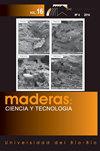椰壳和棕榈仁填料生物复合材料的力学、热学和形态行为研究
IF 1.5
4区 农林科学
Q3 MATERIALS SCIENCE, PAPER & WOOD
引用次数: 1
摘要
本文以椰壳粉、棕榈仁粉和环氧树脂为原料制备了复合材料。制备复合材料样品时考虑添加椰壳粉,利用傅里叶变换红外光谱、扫描电镜和热重分析对制备的复合材料板和刨花板的拉伸强度、硬度、冲击强度、抗弯强度、物理行为吸水率等力学性能进行了形貌测试。实验结果表明,50%椰壳粉复合材料与木质刨花板复合材料的拉伸应力和伸长率的最小变化分别为4.44 MPa和1000%。椰子壳粉复合材料与木质刨花板的最低压应力和硬度变化分别为0、14 MPa和3.2 MPa。经确定,由废壳粉和环氧树脂制成的复合材料适用于面板、汽车内饰仪表板、屋面板和门等应用。本文章由计算机程序翻译,如有差异,请以英文原文为准。
Mechanical, thermal, and morphological behaviour studies on coconut shell and palm kernel filler biocomposite
In the present work, the composite materials were prepared from coconut shell powder, palm kernel powder, and epoxy resin. The addition of coconut shell powder was considered when preparing the composite samples, and mechanical properties such as tensile strength, hardness, impact, bending strength, physical behavior water absorption, as well as morphological tests, were conducted using Fourier Transform Infrared Spectroscopy, Scanning Electron Microscope, and Thermogravimetric Analysis for both the prepared composite material boards and chipboard. The minimal variation of tensile stress and percentage of elongation between the 50 % coconut shell powder composite material and the wooden chipboard material is 4,44 MPa and 1,00 %, respectively, according to the findings of experimental tests.The lowest compressive stress and hardness variations between coconut shell powder composite material and wooden chipboard are found to be 0,14 MPa and 3,2 MPa, respectively. It is determined that the composite materials made from waste shell powders and epoxy resin are suitable for applications such as panel boards, automotive interior dashboards, roof sheets, and doors.
求助全文
通过发布文献求助,成功后即可免费获取论文全文。
去求助
来源期刊

Maderas-ciencia Y Tecnologia
工程技术-材料科学:纸与木材
CiteScore
2.60
自引率
13.30%
发文量
33
审稿时长
>12 weeks
期刊介绍:
Maderas-Cienc Tecnol publishes inedits and original research articles in Spanish and English. The contributions for their publication should be unpublished and the journal is reserved all the rights of reproduction of the content of the same ones. All the articles are subjected to evaluation to the Publishing Committee or external consultants. At least two reviewers under double blind system. Previous acceptance of the Publishing Committee, summaries of thesis of Magíster and Doctorate are also published, technical opinions, revision of books and reports of congresses, related with the Science and the Technology of the Wood. The journal have not articles processing and submission charges.
 求助内容:
求助内容: 应助结果提醒方式:
应助结果提醒方式:


